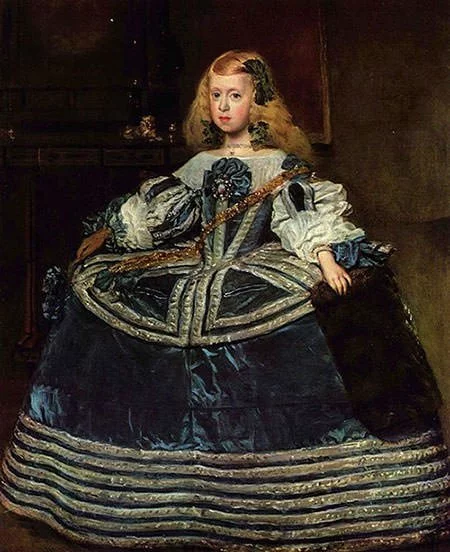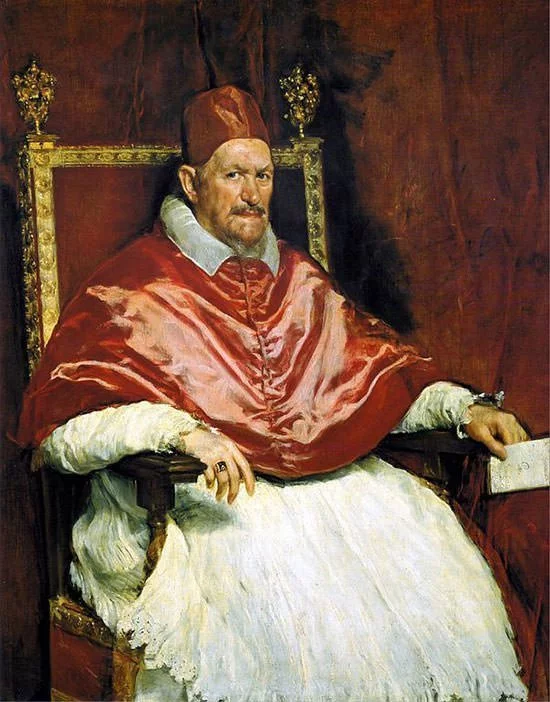Diego Rodríguez de Silva y Velázquez (1599 – 1660) was a Spanish artist active during the 17th century who is considered the foremost figure of the Spanish Golden Age. Velazquez was an important painter during his time and the leading artist in the court of King Philip IV of Spain. His popularity spread outside Spain in the beginning of the 19th century when his artwork became a model for realist and impressionist painters. Since then Velazquez has been regarded as one of the most influential painters in European history and famous modern artists, including Pablo Picasso, Salvador Dalí and Francis Bacon, have paid tribute to him by recreating several of his celebrated works. Know more about the art of Diego Velazquez by studying his 10 most famous paintings.
#10 The Triumph of Bacchus

| Spanish Title: | El triunfo de Baco |
| Location: | Museo del Prado, Madrid, Spain |
| Year: | 1629 |
Known popularly as The Drinkers or Los borrachos, this painting depicts Bacchus surrounded by several drunks. Bacchus is the Roman god of grape harvest, winemaking and wine. His Greek equivalent is Dionysus. The painting can be divided in two halves with the left centered around the luminous Bacchus figure shown in a relaxed but dominant pose; while the right showing a group of drunkards in a very Spanish party atmosphere.
#9 Apollo in the Forge of Vulcan

| Spanish Title: | La fragua de Vulcano |
| Location: | Museo del Prado, Madrid, Spain |
| Year: | 1630 |
This painting depicts the moment in Greco-Roman mythology when the god Apollo visits Vulcan, who is making weapons for the god of war Mars. Apollo tells Vulcan of his wife Venus’s affair with Mars, leading to surprise of all present in the painting, captured masterfully by Velazquez. Some figures in the painting are in front of others to create a sensation of depth for the viewer, an artistic method known as space sandwiching.
#8 Old Woman Frying Eggs

| Spanish Title: | Vieja friendo huevos |
| Location: | Scottish National Gallery, Edinburgh, U.K. |
| Year: | 1618 |
During his early period Velazquez was known for his compositions of amusing genre scenes. Among his greatest paintings of this period, Old Woman Frying Eggs depicts an ordinary scene of an elderly woman cooking eggs, but with great craft and details. In this painting, Velazquez has used the artistic method of strong contrasts between light and dark, known as chiaroscuro. Old Woman Frying Eggs is considered the finest genre painting by Velazquez and is his most famous artwork in this art genre.
#7 Christ Crucified

| Spanish Title: | Cristo crucificado |
| Location: | Museo del Prado, Madrid, Spain |
| Year: | 1632 |
Painted by Velazquez during his middle period, this painting depicts Jesus on the cross immediately after his death. A work of tremendous originality and masterly in its fusion of serenity, dignity and nobility, Christ Crucified is considered a turning point in the artistic development of Velazquez. It is the most renowned religious painting by the artist and has inspired much literature, notably Miguel de Unamuno’s poem El Cristo de Velazquez.
#6 Infanta Margarita Teresa in a Blue Dress

| Spanish Title: | La Infanta Margarita en azul |
| Location: | Kunsthistorisches Museum, Vienna, Austria |
| Year: | 1659 |
This is one of the several court portraits made by Velazquez of infant Margaret Theresa, daughter of King Philip IV of Spain and Mariana of Austria; and who would later become Holy Roman Empress from 1666 till her death at the age of 21 in 1673. The painting is considered a prime example of the immense skill of Velazquez as a portraitist. His portraits of royal children in his later years are among his finest works and Infanta Margarita Teresa in a Blue Dress is the most famous among them.
#5 Las Hilanderas

| English Title: | The Spinners |
| Location: | Museo del Prado, Madrid, Spain |
| Year: | 1657 |
Previously believed to be a depiction of women workers in the tapestry workshop, this painting is now considered a representation of Ovid’s Fable of Arachne by most art critics. In Greco-Roman mythology, Arachne was a mortal woman and extremely talented weaver whose pride got her involved in a weaving competition with goddess of skill and inspiration Athena. During the competition Arachne’s weaving was more beautiful and she also insulted Athena’s father, the king of the Gods, Zeus. This led to Athena turning Arachne into a spider and it is from this fable that the creature gets its alternate name arachnid. Also known as The Fable of Arachne, Las Hilanderas was painted by Velazquez during his last years when his artistic talent was at its peak. It is considered among his most ambiguous and complex masterpieces.
#4 The Surrender of Breda

| Spanish Title: | La rendición de Breda |
| Location: | Museo del Prado, Madrid, Spain |
| Year: | 1634 |
This painting depicts the exchange of keys that occurred 3 days after the surrender of the Dutch fortified city of Breda. The event occurred after the 1624 Siege of Breda by the Spanish army during their Eighty Years’ War against Netherlands. The masterpiece was commissioned by King Philip IV of Spain as part of twelve life-size battle scenes for the Hall of the Kingdoms in Buen Retiro Palace in Madrid. In Las lanzas, Velazquez cleverly chose to illustrate a humane encounter amidst the cruelty of war. The painting is considered one of his best works and is renowned worldwide, but especially in Spain where it is among the most celebrated artworks.
#3 Rokeby Venus (Venus at her Mirror)

| Spanish Title: | La Venus del espejo |
| Location: | The National Gallery, London, U.K. |
| Year: | 1650 |
The only surviving nude by Velazquez, La Venus del espejo depicts Venus, the Roman goddess of love, beauty, sex and fertility, with her son Cupid holding a mirror for her. The painting was bought by English scholar John Morritt in 1813 and he hung it in his house at Rokeby Park in Yorkshire, England thus providing the popular title of the painting. It is now housed in the National Gallery, London. The 3D like quality of Rokeby Venus which makes the viewer feel in touching distance, the flirty effect of Venus staring back, the rich coloring and warm flesh tones have all added to make this masterpiece one of the most erotically charged artworks of all time. The painting made headlines in 1914 when it was vandalized by Canadian feminist Mary Richardson who became known as “Slasher Mary”. It has been faithfully restored since the slashing.
#2 Portrait of Innocent X

| Spanish Title: | Retrato de Inocencio X |
| Location: | Galleria Doria Pamphilj, Rome, Italty |
| Year: | 1650 |
During a trip to Italy, Velazquez offered to paint a portrait of the Pope who asked him to first prove his painting skills. Velazquez’s portrait of his servant Juan de Pareja convinced Pope Innocent X of his talent and this resulted in the creation of this famous masterpiece. The portrait shows such ruthlessness in Innocent’s expression that some feared it would displease the Pope but Innocent X was rather pleased and according to legend said, “Troppo vero!” (“all too true!”). Famous 20th century painter Francis Bacon painted a series of variants of this painting called the “Screaming Popes”, which are now famous in their own right. Portrait of Innocent X is considered by many art critics as the finest portrait ever created while Guardian calls it the most acute study of personal power in the history of art.
#1 Las Meninas

| English Title: | The Maids of Honor |
| Location: | Museo del Prado, Madrid, Spain |
| Year: | 1659 |
Considered one of the most important paintings ever, Las Meninas depicts at its center the 5 year old Margarita Teresa. The infant Margarita is surrounded by her maids, bodyguard, two dwarfs and a dog. On the left, Velazquez depicts himself with a brush, leading to BBC calling this masterpiece “the world’s first photobomb”. Above the princess’ head is a mirror which shows her father and mother, King Philip IV of Spain and Mariana of Austria. They appear to be in position of the viewer. Velazquez perhaps depicts the scene of him painting the royal couple. Las Meninas has been described to represent the “theology of painting” and “the true philosophy of the art” by notable artists. It is the most famous painting by Velazquez, is considered his supreme achievement and is one of the most analyzed paintings in Western art history.

